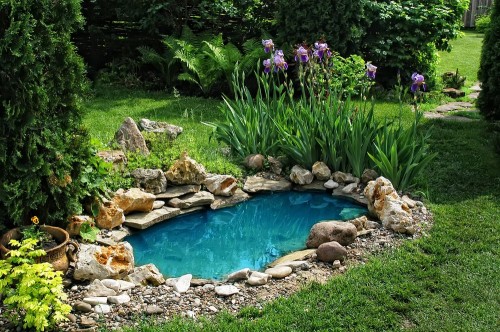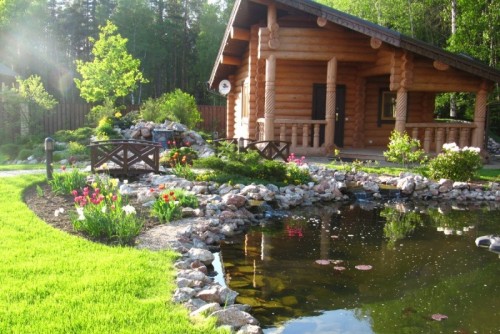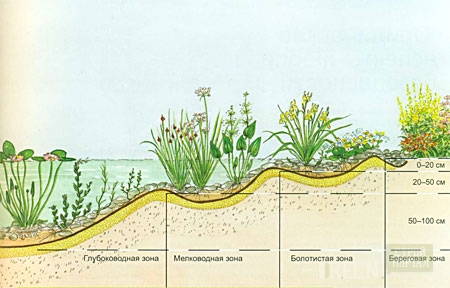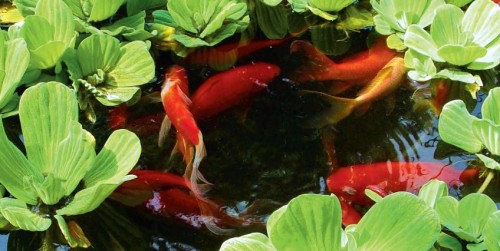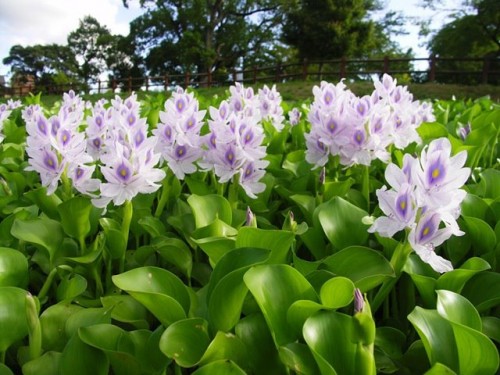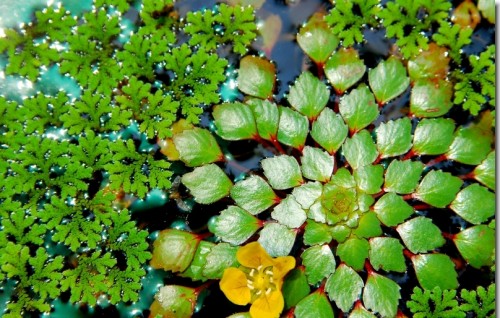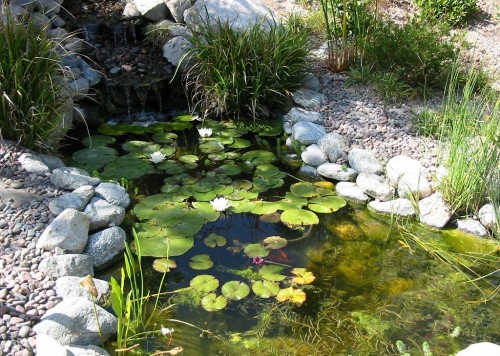
How to zonate decorative pond plants Plot
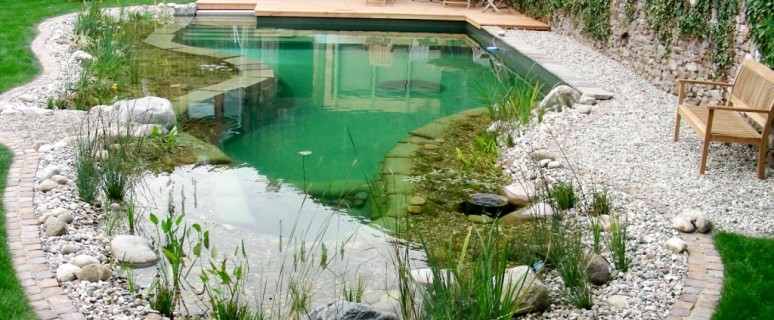
A small reservoir decorated in accordance with the landscape design today is a fairly popular element of country sites. Make a decorative pond with their own hands - an excellent decision, the embodiment of which will decorate any plot. But at the same time, this is a very laborious process that will require some preparation. Decorating the pond, as well as its creation - a complex, but quite justified work that will bring its fruits.
Content
Location and design design
Before start planting plants in a decorative pond, it is necessary to determine the main idea, according to which execution will occur. Anonyus should be denoted, under which the pond comes across a breath. Thus, if the pond is located on a recreation site or the courtyard with a bench, you need to worry about that from this side of the reservoir there is no tall plantation. Here the main thing is the maximum review.
In addition, it is necessary to take into account the plannedness of the decorative composition. Usually the foreground is extracted with low-spirited plants, and then the landing is made as the height of the green decor. It is also important not to overdo it with their number, since in subsequent years the plants will require thinning and care. However, the greatest attention is the vegetation that needs to be attached directly to the pond.
Practical importance of plants
Various handicrafts and plants for a decorative pond with bright flowers, perfect a picturesque landscaped composition of a natural corner of motivated shades and pleasant aromas. But in addition to the external aesthetic, the plants also have a practical purpose.
- Herbs, fully immersed in the pond, are a valuable component of the water ecosystem element. This is the main power component of fish.
- Plants floating on the surface serve for aesthetic appeal, as well as a reliable shield for fish from bright sunlight, as they create a shadow.
- Plants over the aqueous surface serve as a natural filter, which actively adsorb substances falling in the reservoir. In addition, they help to eliminate the effect of the "flowering" of water, as they absorb nitrogen, provoking this phenomenon.
Factors for choosing vegetation
When choosing plants that need to decorate the pond, it is worth holding a single design of the design. This will help to form a holistic composition that will be combined with other elements of the landscape and simultaneously stand out on their background.
In the formation of the general principle of decorating, the following factors must be taken into account:
- The plannedness of the elements - the size and density of the plantations must correspond to the overall landscape plan.
- Zoning plantings - depending on the characteristics of the soil, humidity and depth of the reservoir, the plants must be distributed over zones.
- Water condition - the attractiveness of the reservoir will depend on the quality of water filling.
Zoning of plants in depth
The selection of vegetation for the decorative pond is necessary, taking into account zones. The basic component with zoning is the reservoir depth parameter. Thus, the pond is divided into the following parts:
- deep-water segment;
- shallow segment;
- wetlated segment;
- coastal segment.
- The deepest zone is at a distance of 0.5 m - 1.2 m. Here only bottom plants, underwater vegetation, algae or water flora, which are not rooted in the bottom soil can grow here.
- The shallow water is characterized by a depth of 0.4 m to 0.1 m. All plants growing in this zone have leaves and shoots hidden under the aqueous surface. For shallow water, most varieties of vegetation from the swampy zone will fit.
- The marsh zone is characterized by a constant availability of water, which does not rise above 0.1 m. Vegetation in this part of the pond leaves roots into wet soil or in the aqueous part. In addition, many species of plants are adapted to a changeable level of water.
- The coastal zone is a dry area. The vegetation in this part of the pond is located outside the water surface, but the soil here is quite humid and rarely when dries. Such plants easily carry the sleeve.
Zoning vegetation in varieties
Before how to plant a decorative garden pond with vegetation, it is necessary to take into account the characteristics of plants and soils, which are optimally suitable for a particular zone of the landscape reservoir.
Deep-sea vegetation
Deepive plants with leaves floating on the surface can only grow on the ground or bottom substrate, as they go roots to the bottom of the reservoir. Therefore, they are placed in the pond often in containers. Among the most common varieties of such vegetation are allocated:
- nymfeyman;
- aponoghethon;
- cube;
- orontium;
- cooker;
- lotus;
- water lily.
Winter-resistant varieties of plants are best suited for decorating the pond. For example, among the jugs can be planted white, dwarf, snow-white or fragrant. And for a small reservoir, the optimal option will be a marsh and a nymfeten, which has compact leaves and can grow on a depth of 25 cm. A cube is suitable for shady terrain that does not require intensive lighting. However, it is not recommended to plant more than 2 plants on the square in 1 m 2.
Since the decorative pond has a plastic or concrete bottom, it is necessary to use containers or baskets with soil to disembodit such vegetation varieties. In order to avoid washing out the soil from containers, it is necessary to put the burlap under it, and the top of the soil is sprayed with gravel.
Plants - oxyerators
The decorative pond should be not just aesthetically attractive, but also to have the right biological balance. Without this type of plants, the water will begin to stagnate, is covered with a tina, which entails the appearance of an unpleasant odor. In particular, oxyerators are important for water bodies inhabited by fish.
Oxigenerators externally do not have aesthetic value, but they are necessary for cleaning the pond. They are intensely absorbed carbon dioxide from the water, thereby taking food from algae and preventing reservoir pollution. The most famous representatives:
- bolotnik (Water Star);
- fluffy rogue;
- kaluzhnitsa;
- turcha (water feather);
- rogolitnik;
- ugut;
- elday.
Oxygerators landing - not too troublesome occupation. So that they take root in the reservoir, it is necessary to immerse them into the water. In addition, these underwater inhabitants are not speculating in care, they have cold-resistant qualities and can grow both in the sun and in the shady part of the pond.
The amount and thickness of the plantation can be adjusted by a conventional church, by removing from the surface of the water of the excessive greenery. If in the winter time the pond is not prone to freezing to the very base and does not dry, then these plants easily endure the winter.
Floating vegetation
The reservoir should dwell plants that float on the water surface. They are also designed to filter water in an artificial pond. Such water inhabitants do not require landing in the ground, since their nutrition occurs through the absorption of substances directly from the water.
When decorative a decorative pond, such plants act as a natural "screen", which shares the surface of the water. They are also important in the preservation of the ecological balance, since they absorb the organic dissolved in the pond.
The most common representatives of this group of plants include:
- duckweed;
- azolla;
- rDES;
- water hyacinth;
- pisks.
Among the floating inhabitants of the pond, which bloom beautifully, stand out:
- waterfrons;
- hydrokeeis;
- lironium;
- pemphigus.
Locking of such plants is not recommended in large quantities. And their leaves should not cover more than ½ water surface of the reservoir.
Important! Zoning pond floating vegetation, it is necessary to take into account its tolerance of the cold period of the year. For example, hyacinth will not bloom in the cold summer and there is a risk that he will even perish. Therefore, it follows him in the warm aquarium. Azolla and ores are growing extremely quickly, therefore it is necessary to carefully control their quantity in order to avoid the holistic surface coating of the reservoir.
Outcome
Forming a decorative pond in the country, you can zonate it by plants or in the depth required for plantings. You can beat the contrast of shades and forms when planting coastal vegetation. For example, the high leaves of the iris will contrast with the colors of the swimsuit, and also well combine with openwork fern. The main thing in the formation of the composition is not to rearrange. Aesthetically attractive composition of the pond must take into account the landscaped features of the site.
In addition, before planting plants directly into the pond, it is important to carefully calculate their number and zone of accommodation. It is worth avoiding a thick planting of the aquatic space, since plants need free square to grow. To avoid overcrowding, it is best to choose one representative of the green flora from each type.
Detailed instructions and recommendations for the zoning of the pond by plants can be seen here:




